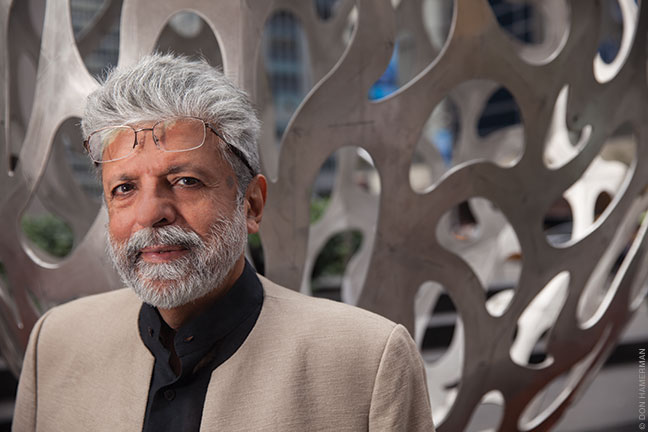
Haresh Lalvani believes there’s a universal code for form—a “morphological genome” that determines the shape of built structures, similar to the way that DNA shapes living things. And he’s well into the process of decoding it.
BY SAMUEL HUGHES | Photograph by Don Hamerman
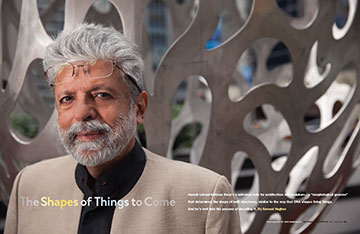
Let’s start with a seed.
Specifically SEED54, the egg-shaped stainless-steel sculpture at 54th Street and Sixth Avenue whose curving, non-repeating apertures frame its creator, Haresh Lalvani Gr’81, above.
Lalvani has spent much of his life observing the shapes and structures of nature, its seeds and pods and fruits and the ways in which they pass on genetic information. He often refers to the Scottish mathematical biologist D’Arcy Wentworth Thompson, whose 1917 book On Growth and Form explored the idea that nature’s growth and structures were governed by physical principles and could be described in the language of mathematics. But that’s only one starting point.
The eight-foot-tall sculpture was originally inspired by a Penrose tiling, one of the non-periodic tiling patterns defined by mathematician and physicist Roger Penrose. In 1981, around the time he was finishing his doctoral work at Penn under the legendary Buckminster Fuller Hon’74, Lalvani developed what he calls a “general case” of the Penrose tiling as a projection from higher dimensions, and he has been exploring the implications ever since.
“SEED goes back to those origins,” he says back in his West Village basement studio, whose floor is covered by his patented crescent-shaped tilings (arranged non-repetitively, of course) and whose walls and ceiling are casually adorned with smaller metal sculptures, prototypes, and paper models. “It’s essentially a new way to divide a surface, or space if you wish, in general.”
That’s the simple version. The longer version involves more details about Penrose tilings than I’m able to regurgitate with any grace—not to mention more details about SEED54’s production than the morphology of this story particle can comfortably accommodate. It’s also only one thin strand of his work. So for now let’s just note that SEED54 is part ofLalvani’s HyperSurface series, which he has described as a “new mathematical class of surface subdivisions that combine aperiodic tilings with any curved surface.”
“SEED54 has a new geometry,” he told Modern Metals magazine three years ago, around the time the sculpture was installed. “We don’t know yet if it exists in nature. Maybe it will, with or without our help.”
The seeming simplicity of HyperSurface pieces like SEED54 “belies their mathematical sophistication,” says Tony Robbin, considered a key figure in the Pattern and Decoration art movement, though he acknowledges that “exactly how and where the repeat of pattern is made continuous and closed is still a mystery to me.” In his view, Lalvani’s overall ability to “visualize the fourth dimension gives him a great road to creativity.”
“Sculpture, by removing function, provides a pure case to understand the fundamental nature of how space, time, and mass are shaped,” Lalvani tells me later. “If our results turn out to be beautiful, it may be because we’ve accessed this insight.”
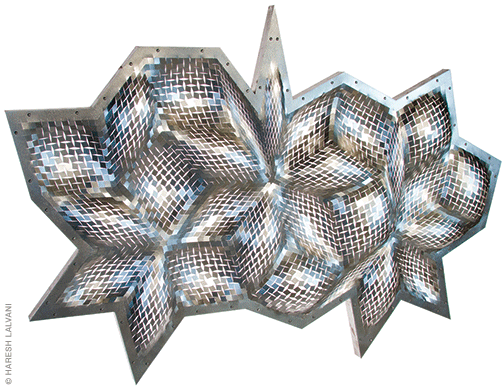
“The ancients fractured god into a thousand gods in order to understand god. To understand light you have to fracture it into a thousand colors. Haresh Lalvani has fractured structure into a thousand facets in order to understand form.”
—William Katavolos, architectural futurist, author of the 1961
manifesto Organics, and co-director, with Lalvani, of the Center
for Experimental Structures at Pratt Institute.
Lalvani is, first and foremost, a morphologist. (Morphology, defined as the branch of biology dealing with the form and structure of organisms, has come to encompass form and structure in architecture and sculpture.) His vision of Meta-Architecture, which he laid out in a 1999 essay for Architectural Design, is based on “manipulating morphologically structured information via algorithms and genetic codes that encipher the formal possibilities of architecture.” He has been pursuing his theories and their practical and impractical applications for many years now, as a professor of architecture at Pratt and co-director of its Center for Experimental Structures, and in his capacity as an inventor of patented creations ranging from a new and improved soccer/sports ball to the technology behind his innovative metal-shaping processes. He is the author of two obscure books: Transpolyhedra and Structures on Hyper-Structures (a slightly reworked version of his Penn doctoral dissertation), as well as many book chapters and articles for magazines and journals, and his awards include the 2002 Pioneers Award from the University of Surrey’s Space Structures Research Centre.
Lalvani suggests wryly that he was drawn to architecture in part because “it’s the only place you’re allowed to combine anything with anything.”
“We just borrow from any damn field,” he says. “My only issue is that we take. Are we giving back?” And his ideas and his work shape-shift their way across disciplinary boundaries so fluidly they might as well be carrying a diplomatic passport.
“He goes into almost every field: medicine, genetics, computers, robots—it’s all applicable,” says Bruce Gitlin, who has collaborated with Lalvani for nearly two decades as CEO of Milgo/Bufkin, the Brooklyn-based custom fabricator of architectural metal. “He hates me to talk about this because it sounds so braggy, but I’ve introduced some friends who are geniuses in other fields to Haresh, and he’ll say, ‘You know, with what you’re doing over there, how about thinking about it like this?’ And they’ll go, like, ‘Oh my god—where did that come from?!’ And he says, ‘Well, it’s logical.’ Well, it’s logical to him, in multi-dimensions. We mortals, on the other hand …”
Try to get your mind around Lalvani’s oeuvre and there’s a good chance you’ll find yourself staring ruefully at the dazzling visual images and theories, sensing their profundity without completely comprehending them. True, I may just be projecting here. Maybe concepts like “decoding the morphological genome” make perfect sense to you from the get-go, right down to the granular details of his designs and fabrications, with their intricate fusions of higher mathematics and biochemistry and engineering. If so, I salute you. You’re in rarefied company.
“Dr. Lalvani is one of the greatest thinker-tinkerers I have ever met, one whose ideas are so big that, cartoon-fashion, they float over my head like giant Macy’s Thanksgiving Day Parade balloons,” wrote design entrepreneur Murray Moss in a recent issue of Interior Design. “I cannot yet comprehend them sufficiently to consider them in my head.”
For someone with such a forceful intellect, Lalvani has a gentle presence and a blessedly unforceful ego. (Asked at the 2004 TED conference what he might be remembered for, he responded: “A brilliant wife, and a brilliant son. And if there is more, it might be for believing in an idea and pursuing it single-mindedly for years.”) Born in Hyderabad (Sind) and raised in New Delhi, his accent is cultured and his manner courtly; for a busy man with a lot of intellectual irons in the fire, he is quite patient, both with digital recording glitches and with questions about his work. He doesn’t dispute my rather half-baked suggestion that there is a spiritual element flowing through his work and thought, albeit in a sense that recalls Einstein, not a sadhu.
“Growing up in India, the spiritualism is embedded, ingrained,” he says. “You don’t even question it. Unconsciously, perhaps, what you do learn is a different way to deal with the world—which is, it’s primarily process, more like a verb than a noun.
“If you talk to any scientist and any serious artist, there’s a spiritual dimension to the work,” he adds. “Why do we do what we do? Creativity is the closest we get to connecting in a very deep way to the rest of the universe. When you make discoveries, you just know you’ve connected. It may not be with the rest of the world, but you’ve connected with something deep. And I think that drives us.”
I began in ’67 essentially—that’s when my eyes opened up and I started looking at nature as the prime source for understanding the world. And therein began the idea that there might be something like the way nature is integrated, there might be a universe, and that it might be built in the manner, perhaps, the way nature builds.
—From Lalvani’s TEDxBrooklyn talk in February 2011.
Lalvani was an undergraduate at the Indian Institute of Technology (IIT) at Kharagpur when his eyes opened up. “I was wondering if there is a universe or multi-verse of forms,” he says, “and why we didn’t use spider silk and bone for building.” For his final architecture project on the morphology of natural and human-made structures, he was told: “Do what you want.”
“That sort of unleashed everything,” he says. “The moment somebody gives you freedom, with that comes a huge responsibility. You start to dig in deeper.”
By then he had begun corresponding with the late Robert le Ricolais, the architecture professor at Penn known as the “father of spatial structures.”
“I would write to him, and he was gracious enough to reply,” Lalvani recalled in a 1994 article for the French architecture publication Le Carré Bleu. Le Ricolais’ comments had inspired him at a time “when morphology was practically unknown in the architectural curricula and profession.” For an unknown undergraduate in India, the older professor’s support of his “persistent interest in natural structure, especially biological structure, gave me much hope then, and today continues to provide me with an enormous source of encouragement.”
Le Ricolais was one of several architectural titans whose innovative structural works captured Lalvani’s imagination early on. Others included the German Frei Otto and the 19th-century Catalonian architect Antoni Gaudí. Then, of course, there was Buckminster (Bucky) Fuller, the University Professor Emeritus at Penn and World Fellow in Residence at the University City Science Center—who, like le Ricolais, had responded cordially to Lalvani’s early correspondence. Internationally renowned for (among other things) his geodesic dome-shaped designs, Fuller even has a molecule—the soccer-ball-shaped buckminsterfullerene, or buckyball—named after him. (Lalvani, who published a 1994 paper titled “Periodic Tables of Buckminsterfullerenes and Related Structures,” has recently returned to the subject of fullerenes and allows that he is “very excited” about some of his new discoveries. Given that “future design will be underpinned by nanotechnology,” he notes, “we need to become familiar with it.”)
Based on the encouraging letters he got from luminaries like Fuller and le Ricolais, the United States “seemed the most open” to his ideas, he recalls. “Hence the goal to get here. The only way was through a student visa. And Penn was my first choice because of Robert’s letters. I still recall his handwritten note guiding me, which said basically, ‘If I were to start over, I would start with geometry as my point of departure.’”
Though he earned his master’s degree at Pratt and joined its faculty in 1970, Lalvani soon made a trip to Philadelphia to meet le Ricolais in person. When he showed the older professor his undergraduate thesis, le Ricolais told him: “You should have been a priest.”
He began attending conferences in genetics and structural biology and met some of the key players in the fields. It occurred to him that just as there is a universal code in nature, “there must be one like this for architecture,” he told his TEDxBrooklyn audience five years ago. “Central to that would be a shape code, what I call a morphological genome, or a morph genome”—one that would provide a “universality” equivalent to nature’s. “For it to be universal,” he added, “the only language we have is mathematics.”
Lalvani’s explorations soon caught the eye of the late Anne Tyng Gr’75, the architect who was famous for—among other things—her geometrical contributions to the field. In 1973 she invited him to give a talk at Penn, where, as an associate adjunct professor of architecture, she was teaching classes in morphology. Among those in attendance was le Ricolais, and at the end of Lalvani’s talk, the distinguished veteran of the Great War spoke up.
“My favorite polyhedron is the octahedron,” he said. “What’s yours?”
“I was taken aback by the question, but he was quite serious,” Lalvani wrote. “I began to wonder about my own favorites for the first time, only to realize that the only polyhedron I liked was the one that kept changing.”
That would be a transpolyhedron, a word that Lalvani coined to describe a transitional form between a polyhedron and its dual. He dedicated his first book, Transpolyhedra, to le Ricolais, and when he decided to pursue in a formal way what he had been exploring informally, he enrolled in Penn’s architectural PhD program in order to study under him. Fate, however, had other ideas.
“I was supposed to be his teaching assistant at that time [1976], but he became ill,” Lalvani recalls. (Le Ricolais died in Paris in 1977.) “Then I found out that Bucky was on the faculty.”
Fuller would write a soaring inscription in Lalvani’s copy of his monumental work Synergetics: “On the intuitively inspiring moment of our association as explorers, operating only on behalf of all humanity, exploring nature’s incredibly beautiful co-ordination of her omni-intertransforming knowledge which is critical to humanity’s continuance on this tiny planet Earth.”
As Lalvani scrambled to register, someone in the architecture department suggested that he contact Fuller—who, it turned out, would be staying at the Plaza Hotel in New York that weekend. Lalvani quickly typed up a three-page letter laying out his interests and discoveries and brought it to the hotel’s front desk on Sunday morning.
“Monday morning, I got a call: ‘Bucky would like to see you.’ So I took the train to Philadelphia. He said, ‘I was very impressed by your letter, and I’m a bit upset that you didn’t come to see me earlier.’” (The context of that last remark was that before contacting Fuller, who he had assumed would be almost impossible to reach, Lalvani had already met with James Watson, co-discover of the DNA molecule, and a number of other leading scientists.)
He appears to have had complete freedom to pursue his dissertation, the title of which was “Multi-Dimensional Periodic Arrangements of Transforming Space Structures,” though when Fuller traveled to New York for the presentation, he held the younger man’s feet to the fire until he was convinced that Lalvani thoroughly understood the lofty and complex concepts he was exploring. (One was that morphology itself has an “underlying morphology”—that is not a typo—and that the “rules that apply here apply at the under-level.”)
Afterwards, Fuller wrote an enthusiastic inscription in Lalvani’s copy of Synergetics 2, stating that he had found his doctoral student’s discoveries “clear, concise and topologically simple.” Having the “privilege of academically judging his qualification for a doctoral degree in design science,” he added, “I find with joy that he is so qualified.”
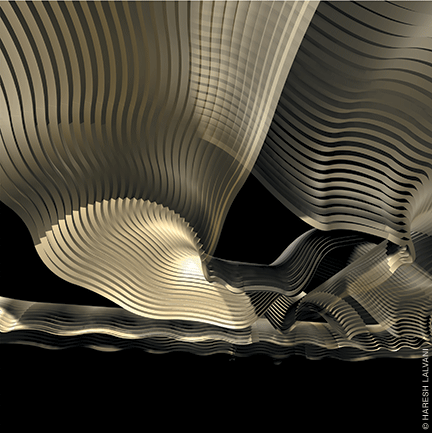
Take a cardboard paper-towel tube. Now, with the heel of your hand, strike it hard at the top. It should crumple at the center, creating several folds. Lalvani, who first learned from le Ricolais that “by crushing structures we reveal what they want to become” (a process he once described as the “beauty of failure”), says that those folds are not random.
“Any skin under force takes on a natural pattern,” he explains. “These patterns have morphological laws, and this method of using force to generate patterns is a different model of morphogenesis, a physical one in contrast to a chemical or a mathematical one.”
There are actually two processes going on, he says. One involves the morphological genome; the other, epigenomics. He compares the latter process to human or elephant wrinkles, which are not part of the DNA’s genetically coded information.
“The wrinkles in a crumpled paper are coming from outside, top-down,” he says. “That’s epigenomics. It’s not coded by the morphological genes.” Crumpling a sheet of stainless steel into a controlled form that is artful or structurally sound and useful is, of course, a lot harder than crumpling a piece of paper.
“It’s easy for anybody to take a box and crush it,” says Bruce Gitlin. The real trick is to make metal “form the crush without using that heavy force.” Neither he nor Lalvani is keen on discussing the details of their patented processes, though Gitlin does say that the “movement of the material is generated by how we treat it beforehand,” adding: “So we do certain things to, in this case, flat metal, and then we apply force, and the material forms in a natural way—following the morphological charts and concepts that Haresh has figured out.”
“The Milgo experiments were about finding new methods, pretty much using conventional technology, so that you can approach material and form in a different way,” says Lalvani. “We have succeeded in making metal, which is a very unforgiving material, pretty much like a fluid. And it’s all cold-formed—we’re not using molds. That’s why these examples are of great interest.”
Several patented processes emerged from these collaborations with Milgo/Bufkin. One is AlgoRhythms, which (to borrow from the Milgo/Bufkin website) “generates a wide range of unique forms from its genetic code” and offers a “wide range of curvilinear structures with fluid movements mirroring the flows of nature.”
Perhaps the best-known AlgoRhythm pieces are the four curving, sensuous columns that the Museum of Modern Art bought in 2004 for its permanent collection. Though most AlgoRhythm pieces have been made from stainless steel, the MoMA columns were made from a single sheet of titanium, and Lalvani goes so far as to say that he would like to build a piece of sculpture in “each metal from the periodic table of elements.” (The uses go beyond sculpture; the process was also used in designing the curving concrete structure for the futuristic residence known as Project X, described below.)
Lalvani and Milgo/Bufkin have also patented his XURF (eXpandable sURFace), which he invented in 1998. A kind of “morphable rigid curved surface” made from continuous sheet materials, usually metal, it can be “variably formed by controlling the interplay between force and form.” It represents a “highly scalable invention with applications ranging from nano and micro scales to product design and architecture.”
One example is X-Tower 88.2, one of Lalvani’s 2014 installations at Omi International Arts Center in Ghent, New York, which drew its inspiration from California’s towering Sequoia trees. (He describes trees as “nature’s anti-gravity inventions,” which “stretch upwards to rise against gravity to shape themselves.”) The sculpture began life as a single flat metal sheet and, with assistance from Lalvani and Gitlin, rose up into a tall, pine-cone-shaped form.
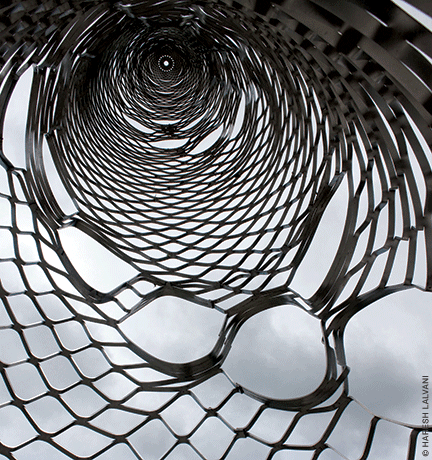
For another XURF experiment at the Grand Rapids Art Museum, Lalvani used an “expanded-metal-type sculpture” that morphed from two dimensions to three and soon started doing a series of “incredible folds.” (Check out this YouTube video for a seed’s-eye view: http://tinyurl.com/okav9j8.) “The surface crumpled itself under force as we played with the metric relation between boundary and interior,” he explains. “The undulations in the surface just ‘emerged,’ all on their own. We had discovered self-shaping. It reminded me of Gregor Mendel’s wrinkled peas.
“It was a surprise,” he adds. “We were changing shape parameters. And by changing those, the surfaces started folding. Then it occurred to me: All these things we see—leaves and flowers and all these ridges folded and so on, they must be a byproduct of something else. A process. And they were beautiful because they happened themselves.”
Making these things happen isn’t just a matter of putting Lalvani’s complex algorithms onto software that can be fed into Milgo/Bufkin’s fancy laser-cutting and water-cutting machinery, says Gitlin. Computers and software are “only tools that you can use to help you along the way. It’s a matter of being in the factory, and working with your hands, and saying, ‘OK, we think this will work,’ and when it doesn’t, you re-analyze it, and you really play with it.” After the problem is finally solved, “sometimes you come up with a methodology that allows us to do it simpler the next time. But most of it is never duplicating anything.
“Haresh doesn’t like to make anything twice—everything is unique, and everything happens automatically,” he adds. “So the concept behind it is very futuristic. Nobody would have even attempted it years ago, because it wasn’t practical. You could just make castings, weld things and grind things—which is anti- what Haresh is doing. Haresh is having things grow from seeds. Really, like trees grow, people grow—he’s got structures growing.”
Lalvani credits his colleague William Katavolos with introducing the concept of “growing architecture” in his 1961 manifesto Organics, which became the basis for what’s known as chemical architecture. In 1973-74, Lalvani wrote an unpublished paper titled “Towards Automorphogenesis: Building with Bacteria.” More recently, his late friend and colleague John Johansen proposed that through nanotechnology, atoms could be encoded with information that would permit controlled self-production.
“The way I see it, scientists and nanotechnologists now are like architects,” Lalvani says. “What they are doing in synthetic biology is phenomenal. We don’t deal with that level of manipulating each atom or molecule at a time, that’s not our expertise. But the spirit is the same. And at some point that lowest level order and granularity has to percolate, all the way up. And I think that’s where we’ll see more harmony between what we do and what nature does.”
In his 1999 Meta-Architecture doctrine, he wrote that the artificial genetic code, when “coupled with biological (DNA-based) or other chemical (physical) building processes, enables growth, adaptation, evolution, and replication of buildings, permitting architecture to design itself and eventually liberating it from the architect.”
“Architecture as we now know it,” he added, “will end when self-architecture begins.”
Today a small number of architects, such as Terreform ONE’s Mitchell Joachim, are exploring the use of living trees and even lab-created artificial tissue to design future habitats that would qualify as “living architecture.” Lalvani, whose systematic morph-code is still a work in progress, says he is “keen to tie it to nature’s building processes at the nano-scale”—and he may be the first to propose linking shape-coding to molecular manufacturing. But, he cautions, “how the morph-code can be tied to physical building at the nano-level—molecular manufacturing—is not known to the best of my knowledge.”
Five years ago, at Design Miami, Lalvani unveiled a series of Morphing Fruit Platters, made of stainless steel through a process he calls Lautomaton—short for Length Automaton. By applying an algorithm to a mass-production design, and feeding the geometries into computer-controlled machinery that marked and laser-cut sheet metal, he was able to, in effect, mass-customize each platter.
“Just for the heck of it, we designed a thousand of them, and we fabricated about a hundred,” he says. “What is constant was the number of holes were the same.
“Of course, they’re all different,” he adds. “But what’s remarkable is that, if you take the solids and voids, what we are throwing away is pretty much the same in all of them, though the shape is different. That means they all are made out of the same amount of material. That’s a good example in design, where we have a procedure and a fabrication method and are reproducing infinite designs that are essentially rearranging matter in a different way, but the same matter is conserved.”
Since cost is a vital factor in industrial processes and products, the conservation angle is key, Lalvani notes. “I said, ‘I’ve got to find a way to guarantee it’s going to cost the same. If you take the length of all these boundaries, add them up, it’s conserved. So that means the total boundary is all the same in each design. That means a laser is going to cut the same length. Laser is a linear tool. Therefore it’s going to cost the same.”
The fact that they used a “very small, kind of inane product,” was beside the point. “Who cares for a fruit platter?” he asks rhetorically. “I wanted billions of them just to make the point that, through an algorithm, you can design for each person on the planet.”
Those inhabitants of the planet who take the A-train, especially on their way to or from JFK Airport, should keep their eyes out for the successor to those fruit platters: Morphing88, a stainless-steel installation commissioned by the MTA for the 88th Street Station. Completed this past July, it consists of 24 laser-cut panels, 12 on each platform. The panels are “stationary points in a continuously morphing pattern that captures time, which is the basis of transport,” Lalvani says. And if “each point has a distinct pattern associated with it—we used GPS coordinates of the street locations to derive the pattern—then infinity comes into play.”
If your life and work are a process, as Lalvani suggests, then there is no real end point. So let’s end with this.
Some years ago, he and his wife, dance scholar Uttara Asha Coorlawala, were visiting the late renowned MIT physicist Philip Morrison and his wife Phyllis at their home in Cambridge.
“I was showing them one of my higher-dimensional tables,” Lalvani recalls. “My wife was getting impatient with the work. ‘But when will it finish?’ she asked. And Phil, pointing to one of the axes on my chart, said, ‘How can it? It goes to infinity!’
“So at what point do you finish?” Lalvani asks. “Because this has been going on for a long time, you know. I don’t know the answer. I think you finish when it stops. You say, ‘I’ve got it.’ Until then, you keep going.”
SIDEBAR
Morphing Toward Project X
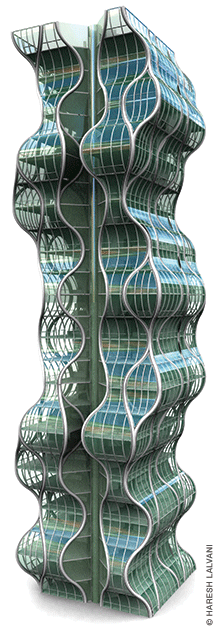
On the southeast corner of the New Delhi property that once held Lalvani’s childhood home stands a 40-year-old Gulmohur tree. When he began to design a three-story residence there some eight years ago, he found the tree to be a mixed blessing: It provided shade and privacy, but it also blocked the sun and the view.
“This required the floors to pivot away from the tree to track the sun, a need felt especially in the cold Delhi winters,” he told Home Review magazine’s Aftab Jalia. “I recall my parents spent their winter months soaking the winter sun. I proposed slightly rotated floors that skewed the layout producing angled spaces in a passive nod to phototropism, the way plants follow the sun.” In a sense, he added, the building, known as B47, was “mimicking the tree it was accommodating.”
B47 is an innovative building on a number of levels. But compared with the dazzlingly futuristic design known as Project X, it’s almost tame.
Back in 2004, New York developer Stanley Perelman—who had worked with Lalvani on Avant, a 13-story residence that Lalvani designed for a space in Chelsea but which was never built—asked him to design a 100,000-square-foot, 25-story residential building for a 100-by-100-foot plot with a 4,000 square-foot footprint.
“I believe in only creating beautiful architecture,” says Perelman, a principal at Jani Real Estate. “Haresh takes that to another level, and it has been my belief that if we construct a building that is so appealing, it will sell at a premium—sort of ‘If we build it, they will come.’”
The idea was to offer the “experience of being inside a skyscraper while still feeling a part of the city,” Lalvani told Home Review in 2012. The undulating exterior glass walls would “open up the sky above and the street below,” providing a “three-dimensional experience of urban space from each home.” A visitor or resident taking the glass elevator on the exterior wall would thus “experience the vertical dimension of urban space” as being continuous with the horizontal as he or she ascended.
Its thermochromic bionic skin—a fancy way of saying a smart façade—was designed to change color as the temperature outside rose or fell. Its curving concrete structure was strong, efficient—and costly.
“The engineers said, ‘Oh, this is efficient. This is better than straight columns,’” says Lalvani. “But then that costs 1.75 times more than the regular [straight] columns.” Then there was the undulating glass exterior, which he says cost two-and-a-half times as much as regular glass.
Engineered by Vincent DeSimone, the engineer for some of Frank Gehry’s buildings, the design for Project X received an award from the American Council of Engineering Companies (ACEC). Lalvani’s AlgoRhythms “allow us to reproduce spectacular structural elements, which twist and torque to nature’s laws,” said DeSimone.
Both Avant and Project X “could have been built and were not theoretical,” says Perelman. “We had architects and engineers at every stage, and we spoke with Permasteelisa [the manufacturing contractor] about Project X, and they were excited to fabricate the curtain wall. DeSimone, our structural engineer, found that the frame was stronger than a typical steel or concrete rectilinear frame.
“I have total faith in Haresh,” Perelman adds. “He didn’t just draw pretty pictures. He had worked out all the kinks before presenting it to me.”
Perelman was still scouting for the right piece of land when the market crashed in 2008. Since land and construction costs stayed roughly the same, Project X never got off the drawing board.
At that time Lalvani recalls, Perelman’s final words were: “Haresh, you’re too outside-the-box for Manhattan.” But the builder has not given up on the project.
“I just spoke to an investor today about it,” Perelman said early last month. “The rendering is in my conference room, and everyone who sees it is impressed. Haresh is brilliant—perhaps the smartest and most interesting person I have ever had the pleasure of working with on the planet—and one day I will find the appropriate site in Manhattan to build it with him.” —S.H.


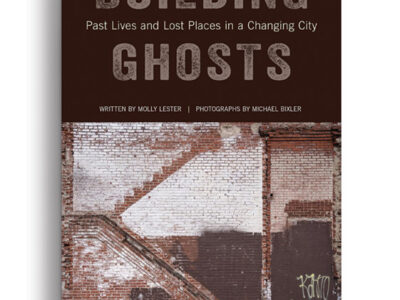
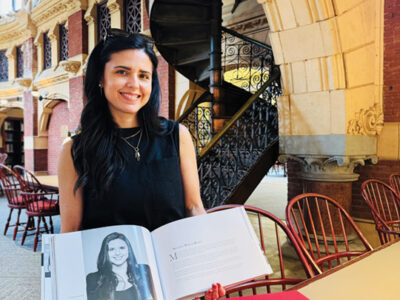
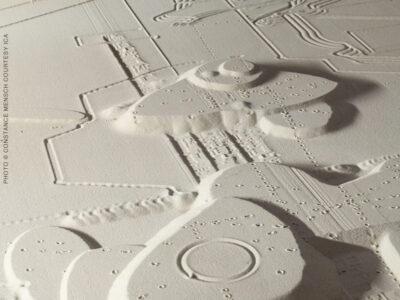
Hello Dr. Lalvani,
Fantastic work Haresh. I am one of your devoted students at Pratt Institute, New York. I was your student in the eighties and unfortunately lost contact with you. I am here contacting you regarding an upcoming publication that will require your esteemed contribution and hope that this message gets to you, Kindly contact me on the above email for details . Thank you.
regards
AsuQuo Ukpong , New York